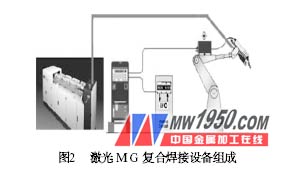Abstract: The competition of laser technology strengthens the application of laser welding technology in the automobile manufacturing industry. The new laser welding power supply and higher power make laser welding into the manufacturing field of automobile bodies that have long been monopolized by traditional welding technology, making laser technology widely used in the automotive industry. The laser mixing welding technology can greatly improve the connection ability of the gap of the stamping part, and more fully utilize the process stability of the arc welding during high-speed laser welding.
At present, laser and its composite welding technology have been applied in many industrial sectors, and the automobile is the most important one. The most typical examples are the laser-welding of the body cover and the welding of the top and side. Several thin plates of different thicknesses, materials and properties are welded together by laser and then stamped and formed. Not only improved material utilization, from 40% to 60% to 70% to 80%, but also reduced weight and improved overall mechanical properties. Compared with a single laser welding technology, laser hybrid welding technology has significant advantages: greater penetration, greater gap weldability and better weld toughness, which can affect weld microstructure and weld-free joints. Back sagging phenomenon, etc.
First, the principle of laser welding
Laser welding uses a laser as a welding heat source and a robot as a motion system. The special advantage of the laser heat source is that it has extraordinary heating capacity and can concentrate a large amount of energy on a small point of action, so it has the characteristics of high energy density, concentrated heating, fast welding speed and small welding deformation. Achieve quick connection of thin plates.
When the power density on the laser spot is sufficiently large (>106 W/cm 2 ), the metal is rapidly heated by the laser irradiation, and the surface temperature rises to the boiling point in a very short time, and the metal is vaporized. The metal vapor leaves the surface of the molten metal bath at a certain speed, creating an additional stress that reacts to the molten metal, causing it to sag downward, creating a small pit under the laser spot. As the heating process progresses, the laser can be directed into the bottom of the pit to form an elongated "small hole." When the recoil pressure of the metal vapor is balanced with the surface tension and gravity of the liquid metal, the small holes are no longer deep. When the spot density is large, the resulting small holes will penetrate the entire plate thickness to form a deep penetration weld. The aperture advances along the welding direction as the beam is directed relative to the workpiece. The metal melts in front of the small hole, bypasses the small hole and flows backward, and the weld formed by re-solidification is shown in Fig. 1.

Second, laser welding equipment
Laser welding equipment is mainly composed of laser, light guide system, welding machine and control system as shown in Figure 2.

Laser
The lasers used for laser welding are mainly CO2 gas lasers and YAG solid-state lasers. The most important properties of a laser are output power and beam quality. Considering these two directions, CO 2 lasers have great advantages over YAG lasers. They are the main lasers used in deep-fusion welding. Most of the applications in production are still in the range of 6 to 15 kW. YAG lasers typically have a power of less than 1 kW and are used for micro-joining of small parts. In recent years, foreign countries have made breakthroughs in the development and production of high-power YAG lasers, with a maximum power of 5 kW, and have already invested in the market. Due to its short wavelength, it is only 1/10 of the CO 2 laser, which is good for metal surface absorption and can be transmitted by optical fiber to simplify the light guide system. Therefore, high-power YAG laser welding technology will develop rapidly in the future and become a strong competitor of CO 2 laser welding.
2. Light guide and focusing system
The light guide focusing system consists of a circular polarizer, a beam expander, a mirror or an optical fiber, and a focusing mirror to realize the function of changing the polarization state and direction of the beam, and transmitting the beam and focusing. The condition of these optical components has an extremely important influence on the quality of laser welding. Under the action of high-power laser, the optical components, especially the lens performance, will deteriorate, the transmittance will decrease, and the thermal lens effect will be generated, and the surface contamination will also increase the transmission loss. Therefore, the quality, maintenance and working condition monitoring of optical components is essential to ensure the quality of the welding.
3. Welding robot
Because the laser-MIG hybrid welding technology requires less assembly precision for the welded joint, it is not necessary to use the laser brazing robot design method, which is different from the conventional winch-type welding robot, and there is no need to design the automatic seam tracking correction system. Laser on-line inspection system, which can greatly reduce the cost investment of tooling equipment and reduce the complexity of tooling design.
Next page